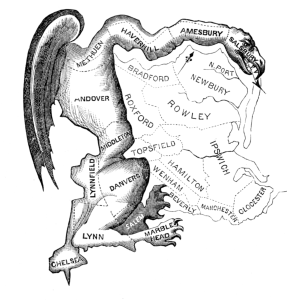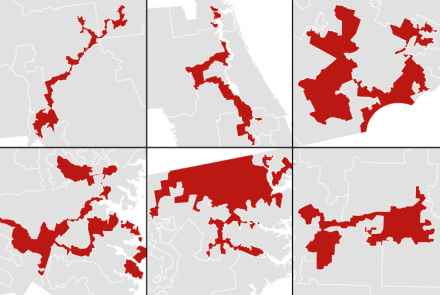Gerrymandering Our Demise

The graphic above is an historically famous newspaper illustration of the first application of redistricting based upon choosing voters likely to vote for one party over the other, thereby assuring the election of a favored candidate. The map is of Massachusetts' counties in 1812 and how they were cobbled together by redistricting to elect congressional candidates favored by Governor Elbridge Gerry. Newspaper wags thought the result looked like a salamander and dubbed the creature a "gerrymander."
A recent exchange I had with a Political Science colleague over some electoral studies we've conducted separately illuminated for me how redistricting, or gerrymandering, is contributing greatly to our national political polarization and governing dysfunction.
After the presidential elections of 2000 and 2004 I became quite curious about the red state-blue state narrative promoted by the media to explain the election results. The narrative keyed on subcultural stereotypes across America that served to define political preferences. Most of us are familiar with such stereotypes (guns and religion vs. Priuses and lattes), but it struck me then that the differences had to be more correlated with geography than cultural identity. After all, red-blue was a geographic pattern, so it had to incorporate a geographic explanation. I conducted an empirical study of those elections that compared county voting with county census demographics. The results revealed that the most significant factors determining party preferences were population density and household formation. Other census characteristics--such as race, gender, age, income--added no explanatory power. (In 2005, I published an op-ed explanation here.)
To bring us up to date, I read another study last week (titled, The 2014 House Elections: Political Analysis and The Enduring Importance of Demographics) that analyzed the 2008, -10, -12, -14 elections in the same manner, comparing census demographic data with congressional district results. The author found that the two most important factors were population density and race/ethnicity of minority vs. white voters. At first I wondered why our results differed, as I suspected nothing much had changed in the electorate beyond a presidential candidate who was the first African American in US history. After some discussions I realized the differences between counties and Congressional districts (CDs) is because county lines, like state lines, are not redrawn to influence electoral outcomes while CDs are deliberately redrawn to favor those outcomes.
Below are some examples of tortuously drawn CDs that are intended to bind racial and ethnic communities together to elect racial and ethnic representatives in a white majority nation.

It didn't take long to figure out that the difference between the results of the two studies can be traced to the unit of analysis: counties vs. congressional districts. Counties reflect a cross-section of lifestyle preferences based upon geography and demographics versus congressional districts that are carved out to achieve a desired electoral outcome based solely on race or ethnicity.
Underlying this policy objective is the assumption that only a racial or ethnic minority candidate can adequately represent a racial or ethnic community. We can debate whether this assumption holds true or not, but the unfortunate result is that gerrymandering reinforces the bias. In other words, if we're looking for racial bias and then organize our electoral system to reinforce racial and ethnic divisions, is it any wonder that we then find a correlation between race and political outcomes?
There are other pernicious effects of redistricting along racial and ethnic demographics. First, it reduces electoral competition, and this works equally well for both parties. As non-whites get carved out of white districts, the remaining districts are more purely white. In effect, we are sectioning our electorate into white and non-white political entities. This goes against our long-running public battle to integrate communities, but reducing electoral competition also means parties and candidates can become less responsive to voters' demands and not suffer for it. This translates into democratic governance that is anything but "of the people, by the people, and for the people."
Second, democracy is founded on the process of compromise, but how does a political group defined by biological identity compromise? It becomes impossible to compromise one's racial, ethnic or sexual identity, so we get much less compromise on issues that go beyond biology. This inability to compromise has greatly hampered our democratic governance. We have basically yielded our politics to a class of elites who are highly motivated to secure and wield power and wealth in their favor: the 99% governed by the 1%.
Taken in total, regardless of the political benefits, what gerrymandering and redistricting has done is weaken our commitment to one of the founding tenets of the American experiment, expressed in the Latin words, e pluribus unum: Out of One, Many.
Instead we've allowed ourselves to become too easily divided and conquered.


